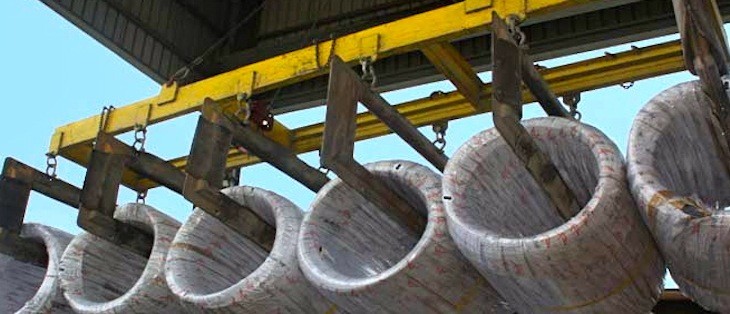Arkansas River commerce up almost 6% through May
by June 10, 2020 3:54 pm 642 views

Steel shipments at the Port of Fort Smith.
Commercial traffic on the Arkansas River is up 5.8% through the first five months of 2020 compared with the same period in 2019. The increase is primarily attributed to record flooding in May 2019, although sand and gravel shipments are on the rise.
May traffic was 872,557 tons, up 480.5% compared with the 150,316 tons in May 2019. The historic flooding hit the Arkansas River (McClellan-Kerr Arkansas River Navigation System, or MKARNS) in May-June of 2019 after rains of up to 600% above normal in northeast Oklahoma and southeast Kansas overtook the capacity of Oklahoma reservoirs to store the water. River tonnage in 2019 totaled 8.48 million tons, down 22% from 2018.
During the first five months of 2020, river commerce totaled 4.281 million tons, up 5.8% from the 4.048 million tons in the first five months of 2019, according to the U.S. Corps of Engineers report posted Wednesday (June 10). The biggest gain in traffic was with internal shipments, or cargo shipped between ports on the river. That segment recorded 1.206 million tons, up 54% from the 737,991 tons in the first five months of 2019. Outbound traffic was down 18% and inbound traffic was down 7.2%.
Following are the top five shipment categories by tonnage for the first five months of 2020, with the percentage change from the same period in 2019.
• Sand, gravel, rock: 1.331 million tons (up 49%)
• Chemical, fertilizer: 1.002 million tons (down 28%)
• Wheat: 447,873 tons (up 24%)
• Iron & steel: 421,312 tons (down 42%)
• Soybeans: 413,900 tons (down 17%)
The Arkansas River system is 445 miles long and stretches from the confluence of the Mississippi River to the Port of Catoosa near Tulsa, Okla. The controlled waterway has 18 locks and dams, with 13 in Arkansas and five in Oklahoma. The river also has five ports: Pine Bluff, Little Rock, Fort Smith, Muskogee, Okla., and the Tulsa Port of Catoosa in Oklahoma.
Marty Shell, owner of Van Buren-based Five Rivers Distribution which has port operations in Fort Smith and Van Buren, said tariffs on imported steel have resulted in a big hit for his business and is likely are reason for the decline in iron and steel river shipments.
“I was hoping for stronger numbers for 2020, but tariffs, COVID-19, and a recession is hurting all industrial sectors. I would hope the current (Trump) administration would focus on tariff trade agreements soon and with the opening back up of the economy the small and medium business sector will do what it’s always done and make the economy strong and pull the nation out of the economic recession it is in,” Shell told Talk Business & Politics.
Bryan Day, executive director of the Little Rock Port Authority, said river commerce is still being hurt by the COVID-19 induced recession. He said the rise in internal shipments could also be fueled by “dredge material being shipped up and down the river between ports.” He also said low oil prices and the impact on oil and gas exploration and drilling is behind the decline in iron and steel shipments.
The Arkansas River system is 445 miles long and stretches from the confluence of the Mississippi River to the Port of Catoosa near Tulsa, Okla. The controlled waterway has 18 locks and dams, with 13 in Arkansas and five in Oklahoma. The river also has five ports: Pine Bluff, Little Rock, Fort Smith, Muskogee, Okla., and the Tulsa Port of Catoosa in Oklahoma.
